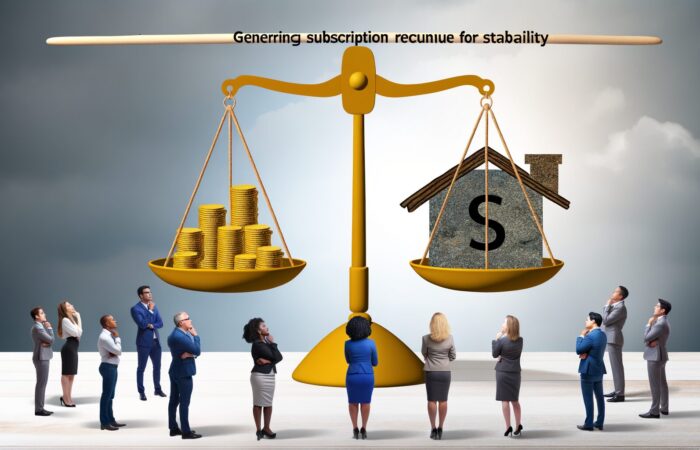Welcome to the World of Alternative Monetization Strategies!
Are you looking to give your revenue streams a little shake-up? Whether you’re a burgeoning startup, a seasoned business, an indie artist, or just curious about the economic side of creative fields, having a solid grasp on alternative monetization strategies can be a game changer. Fret not—getting acquainted with these intriguing avenues is as fun and enlightening as exploring a new city!
As the digital landscape continues to morph and expand, traditional revenue channels—be it straightforward sales, simple service charges, or basic advertising—are being flanked by more innovative, and often, more sustainable approaches. This isn’t about reinventing the wheel but rather picking out new spokes from an ever-growing wheelhouse of options.
Curious about why you should focus on alternative monetization? It’s simple: **diversity in your income sources can lead not only to more financial stability but can align more harmoniously with your brand, expand your reach, and develop deeper relationships with your customers or fans.
But what exactly falls under ‘Alternative Monetization’?
Simply put, it’s any method of generating revenue that veers off the beaten path of traditional techniques. You might remember the classic examples like product sales or billboards. However, alternative strategies might include—expect no spoilers!—other fascinating models which we will dive into throughout this guide.
Why Opt for the Road “Less Traditional”?
- Innovation: It encourages creative approaches to making money that can differentiate you from competitors. Imagine attracting attention just by the uniqueness of your monetization method. Cool, right?
- Engagement: These methods often involve more direct interactions with your audience or customers, establishing a deeper bond. Think of it as hosting a large dinner party—everyone feels part of something special.
- Resilience: Relying solely on old-school methods can be risky in this fast-paced world. Spreading out into varied channels makes your cash flow more immune to market fluctuations and satiates the appetite for novelty and efficiency demanded by modern consumers.
On our insightful journey, we’ll venture through some standout strategies such as subscription-based models, where consistency meets reliability, or delve into the realms of crowdfunding where community support can translate directly into impressive funding—a beautiful synergy of trust and innovation.
So buckle up! Preparing yourself with an array of alternative monetization strategies not only sets you up for economic growth but also embeds a spirit of agility and forward-thinking in your project or business. Think of it as putting on those versatile all-terrain shoes that promise comfort and readiness whatever the journey ahead entails!
Stay tuned as we take a detailed trek through each unique monetization strategy. It’s going to be quite the rewarding journey!
Subscription-Based Models: Gaining Steady Revenue Streams
Ever wondered how some businesses, especially in the digital realm, maintain a predictable cash flow even in fluctuating markets? Well, the magic often lies in their adoption of subscription-based models. This method is far from new—think back to the good ol’ magazine and newspaper subscriptions. However, they’ve pivoted masterfully with the times to suit modern day consumer needs across various industries.
Why go subscription? The appeal is pretty straightforward. It transforms one-time buyers into regular customers, smoothing out revenue bumps and providing vital financial predictability. This consistence allows companies to focus better on innovation and customer service rather than unpredictable sales cycles.
Creating a Robust Subscription Model
So, you’re intrigued and ready to leverage this model? Here’s how to set up an appealing subscription service:
- Assess your product’s suitability: Not all products or services are ideal for subscriptions. The best fits are those that offer ongoing value, like access to digital content, regular software updates, or routine deliveries of perishable items.
- Set clear, compelling tiers: People love options. Offer various subscription tiers to accommodate different needs and budgets. This approach not only broadens your market reach but also enhances customer satisfaction by offering precisely what they need.
- Prioritize flexibility: Today’s consumers favor control and flexibility. Easy subscription modifications, pauses, and cancellations can make your offer much more attractive.
- Focus on customer relationships: A successful subscription model thrives on long-term relationships. Regular updates, personalized communications, and exceptional service are imperative to keep satisfaction high.
The beauty of subscriptions also comes from their ability to be paired with other revenue channels. For instance, a primary service could be enhanced with “add-ons” or premium features, nudging subscribers gently towards higher revenue generating tiers.
Examples that Shine
Need some inspiration? Look at platforms like Netflix or Spotify. They revolutionized the entertainment industries by moving from a pay-per-product to an all-you-can-consume model under a monthly fee. They emphasize continuous value provision, keeping their audiences hooked and revenue streams healthy.
But it’s not just tech giants that get to have all the fun. Smaller businesses, local gyms, and even specialty food providers have successfully implemented subscription services, showing its versatility across realms.
The Takeaway
Embracing subscription-based models can be a game-changer for businesses seeking regular income and closer customer connections. By focusing on consistency, customer satisfaction, and flexibility, subscriptions can transform the nature of your transactions from erratic to enthusiastic. Ready to dive into a registration form and recurring billing? It might just be the steadying solution your business has been searching for!
Freemium Tactics: Balancing Free Access with Premium Features
So, let’s dive right into one of the most intriguing strategies out there: the freemium model. You’ve probably come across it more times than you can count. Think of your favorite smartphone apps. How many did you start using for free, only to find yourself paying for bonus features? This strategy is a clever one, shifting seamlessly from ‘free’ to ‘premium.’
At its heart, freemium models capitalize on a very human characteristic: curiosity. We’re wired to try out things that don’t cost us anything. Once we’re hooked, unlocking advanced features for a price seems like the next logical step. Who doesn’t love getting more of a good thing, right?
It’s All About Added Value
What makes the freemium model tick? Added value. It offers a basic version of a service or product that’s good enough to stand on its own, but tantalizes with the promise of even better perks if you’re willing to pay. A freemium game might let you progress at a reasonable pace initially but offer in-game purchases that make the experience faster or more interesting.
- Messaging apps like Slack or Discord provide solid communication tools for free, but if you’re running an organization, chances are you’ll ponder upgrading to get advanced functionalities like security controls or better data retention.
- Storage services, such as Google Drive, seduce you with a decent chunk of free space, then gently nudge you towards their premium plans as your storage needs outgrow the free limit.
Why Does It Work Remarkably Well?
The beauty of the freemium approach comes from its flexibility. Users are never forced into paying. Instead, they’re shown how much more enjoyable or efficient their experience could be with just a few extra perks. This psychologically savvy approach shifts the user’s mindset from “Do I need this?” to “How did I ever manage without this?”
But it’s not enough to just offer more of the same. The key is to identify features that are irresistible yet not necessary for the basic function of your product. These should enhance user satisfaction and engagement without leaving those on the free plan feeling left out.
- Keep It Accessible: Make sure the free version of your product is competent and enjoyable. Never compromise on the base quality – after all, it’s often the gateway to premium upgrades.
- Create Desirable Extras: Develop premium features that are convenient, enhance productivity, or offer aesthetic upgrades users don’t want to resist.
- Offer Smooth Upgrade Paths: Make the transition from free to premium as easy and tempting as possible. Limited-time free trials of premium features can be an excellent tactic.
To wrap it up, as we navigate this freemium territory together, think about how you can apply these principles in your strategy. Whether you stack up more advanced features, provide special customer service, or design visually appealing extras, remember it’s all about fostering an environment where upgrading feels like a natural expansion of one’s experience. So go ahead, how will you let your users enjoy their teaser taste of your service, all while paving the way to that premium buffet?
Sponsorship and Partnerships: Leveraging Brand Collaborations
When it comes to growing and monetizing your business or project, the smart use of sponsorship and partnerships can be akin to finding a treasure chest in the sprawling ocean of opportunities. It’s not just about boosting your income; it’s about creating symbiotic relationships that benefit all involved parties. Let’s dive into how nurturing these collaborations can set the stage for robust growth.
Understanding the Essentials
At its core, a sponsorship or partnership involves aligning with another business or brand that shares your values and target audience. This unity can provide essential financial support and access to wider audiences. Picture this: you’re a new organic-skincare brand. By partnering with a popular health and wellness influencer or another like-minded brand, you instantly gain access to health-conscious consumers who are likely your target market.
Choosing the Right Partners
It’s crucial to be selective with whom you partner. The essence of a good partnership is not only in mutual benefit but also in shared ethos and vision. When you pick a partner whose business ethos aligns with yours, their audience is more likely to trust and engage with your brand, as there’s an implied endorsement. Trust is the currency here!
- Research Potential Partners: Look into their business practices, audience demographics, and brand values.
- Evaluate the engagement they generate: Are their followers interacting in meaningful ways? This gives insight into how well they might advocate for your product or service.
- Start small: Consider a short-term project to evaluate the partnership dynamics before committing to a long-term agreement.
Maximizing the Benefit
Imagine this partnership isn’t just a business arrangement; it’s a vessel that drives brand appeal and exposure. So, how can you pour rocket fuel into this vessel? For starters, create co-branded content that resonates with both your backpackers. Engage together in activities and campaigns that tell compelling stories to captivate your joint audience.
Authenticity in these initiatives is crucial. When the audience feels the genuine commitment from both sides, it subtly strengthens their loyalty to both your and your partner’s brand.
- Collaborate on a special product: Something that combines the essence of both brands can be a powerful market move.
- Joint events or webinars: Use these platforms to educate audiences while simultaneously displaying the power of your partnership.
- Social media takeovers: Allow partners to take over each other’s social channels to cross-pollinate audiences and grow your follower base.
Engaging in sponsorships and partnerships is an exciting expedition, full of opportunities and mutual growth. It’s more than just a logo placed beside another; it’s about weaving your brand into new markets and tales. So, when considering your next business move, think what aligns with your philosophy and might tickle fancy of your potential clientele. Remember, in the dance of collaboration, synchrony is key!
Merchandising: Developing Brand-Related Products
Ever admired those nifty mugs or nifty T-shirts showcasing your favorite tech brand or influencer? That’s merchandising in action—a fun and creative revenue stream that both enhances brand presence and boosts income. And let’s be real, who doesn’t love good branded swag?
Merchandising doesn’t just capitalize on brand loyalty; it celebrates it. Fans and customers love to physically manifest their allegiance and passion for a brand, and merch gives them a perfect avenue to do just that. From apparel to planners, the possibilities of generating a substantial income stream are quite varied and exciting.
Getting Started: What To Merch?
Begin by taking a survey of your audience—find out what products they might be interested in. Would they wear a hoodie with your logo? Are they the type for hats, pins, or stickers? Pro tip: combine this research with analysis of your most engaged segments to create designs and products that truly resonate.
Design & Development
Once you’ve pinpointed some potential hit products, the fun really begins. Design is key! Engaging a skilled designer who understands your brand’s aesthetic can make or break your merch line. Remember, it’s not just about slapping your logo onto various items. Integrate your brand’s colors, slogans, and personality into every item to make the merch feel genuinely exclusive and worth buying.
- Quality is Crucial: The better the quality, the more likely your customers will use it, wear it, and, even better, share it. Satisfied customers turn into walking billboards!
- Scalability: Start small, but plan for the future. Depending on how your initial offerings perform, you’ll want to swiftly adapt and expand your product range.
Marketing Your Merch
Just creating some cool merchandise isn’t enough. You’ve got to let your fans know it’s out there! Use your existing platforms—be it email newsletters, social media, or your website. Create engaging content that showcases your merchandise in use. Lifestyle shots, customer reviews, and creative product placement can do wonders for visibility and appeal.
Offer exclusivity through limited-time offers or members-only merchandise to create a rush and
emphasize the uniqueness of your brand’s products. Ever consider the power of unboxing? Why not get some influencers to do “unboxings” of promotional packages you send out? The visual impact and wide reach can boost initial excitement and sales significantly.
Best Practices
- User Experience: Make purchasing easy. Ensure your e-commerce setup is user-friendly, and test everything from mobile compatibility to load times to minimize snags in the purchasing process.
- Feedback: Actively seek out feedback and be prepared to make adjustments. This two-way communication will not only optimize your product offerings but also build stronger relationships with your customers.
Incorporating merchandising into your monetization strategy not only opens up a fun and potentially lucrative revenue stream but also strengthens your community’s connection to your brand. Remember, people love to be associated with their favorite brands, and with the right approach, you can make that association a profitable venture!
Crowdfunding and Patronage: Engaging Your Community Directly
When it comes to embracing your passionate community for direct support, crowdfunding and patronage are like the superheroes of alternative monetization strategies. These methods not only open financial channels but also reinforce the bond between creators and their audience. Here’s a deeper dive into how these strategies can elevate your project or initiative!
Understanding Crowdfunding
If you’ve ever wondered how that indie movie got off the ground or how a small tech gadget managed to see the light of day, crowdfunding might just be the answer you’re looking for. Crowdfunding platforms like Kickstarter, Indiegogo, and GoFundMe transform the collective power of supporters into an incredible funding force. But it’s not all about just asking for money – it’s a narrative. You share your vision, your story, and enthusiasts who believe in your idea chip in to help make it a reality.
Key Strategy: Launch a compelling campaign. This involves setting clear goals, creating compelling content (like videos and blog posts), and offering enticing rewards that echo back to your pursuers’ generosity. Remember, it’s about making funders feel as they’re part of the journey!
Patronage Platforms Making a Comeback
Patronage isn’t a new kid on the block. It’s a time-tested model refreshed for the digital age. Platforms like Patreon allow creatives to receive ongoing support directly from their fanbase. Whether you’re a podcaster, an artist, or a writer, patronage can provide a sustainable income stream that grows as your follower base grows.
- Consistent Support: Unlike one-off project funds that come via crowdfunding, patronage offers a consistent monetary flow. It’s about having a group of dedicated patrons who support you on a monthly basis.
- Community Building: Forge a close-knit community. Beyond just financial contributions, your patrons can provide feedback, share ideas, and participate in exclusive content sessions. It’s like having your own fan club!
Why These Tools Rock
Now, you might be thinking, “why not just stick to traditional ways of monetization?” Well, unlike traditional models that often distance the creator from their audience (think paywalls and pricey tickets), crowdfunding and patronage foster a sense of partnership. They democratize the creation process, prioritizing transparency and participation.
- Transparency Is Key: When followers fund you, they appreciate openness about where their money goes. Regular updates and honest chats make a difference.
- Inclusivity Wins: With crowdfunding and patronage, almost anyone can contribute according to their ability. It’s not about deep pockets but about deep appreciation for what you do.
In short, if you’re looking to engage directly with your audience while fostering a dedicated and supportive community around your work, then bringing crowdfunding and patronage into your monetization mix might just tip the scales in your favor. So why not give it a shot? After all, it’s about getting closer to those who matter most—your community!
Licensing Content and Intellectual Property: Expanding Income Sources
Alright, let’s dig into one of the most intriguing corners of alternative monetization — licensing content and intellectual property. This is especially juicy if you’re a creator or business looking to expand your income without continually reinventing the wheel!
Imagine this: Your creative work, be it illustrations, music, software, or even that quirky character from your blog, could be earning you money while you sleep. This happens through licensing agreements, where you allow others to use your assets in return for compensation. Exciting, right?
How Licensing Can Benefit You
Licensing isn’t just for the big players. Individual creators, small startups, and mid-sized companies can massively benefit from this model too. Here are a few perks:
- Passive Income: Licensing deals can offer a way to earn money repeatedly from a single piece of created work.
- Reach Expansion: Your work finds its way into varied markets and uses that you may not have access to or never considered.
- Brand Building: It positions your brand in front of diverse audiences, enhancing your visibility and credibility.
Now, let’s explore how you can make this happen!
Steps to Get Started with Licensing
1. Identify Valuable Assets: Scrutinize your portfolio for content that has potential for licensing—anything that’s distinctive, popular, or highly specific might just be perfect.
2. Protection First: You need to ensure your intellectual property rights are secure. Copyrights, trademarks, or patents might be relevant depending on your content type.
3. Find Suitable Partners: Look for companies or individuals that might benefit from using your work. Licensing databases and industry tradeshows are great places to start.
4. Negotiate Terms: Terms involving duration, exclusivity, and payment structure need to be clear and mutually beneficial. This might require a bit of negotiation—you want the deal to be as lucrative for you as possible!
Real-World Examples of Licensing Success
To really get you excited, consider some success stories. Ever heard of Jim Davis’ lasagna-loving cat, Garfield? Beyond comic strips, Garfield has been licensed for toys, clothing, and more, forming a huge part of the brand’s income. Or how about J.K. Rowling’s Harry Potter series? From books to movies, merchandise, and even theme parks, licensing has turned it into a multi-billion-dollar brand. Both show the power of leveraging IP through strategic licensing.
Entering the world of licensing might seem daunting at first, but with proper research, protection, and strategy, it can open up a treasure trove of opportunities. Whether you’re sitting on a goldmine of graphical assets, witty catchphrases, innovative software, or enchanting music scores, licensing could be your ideal route to a new revenue stream.
Embrace this smart strategy and watch your creations reach new markets and achieve new goals. Your intellectual property could be your most valuable asset, so start considering how licensing could work for you!










No Comment! Be the first one.